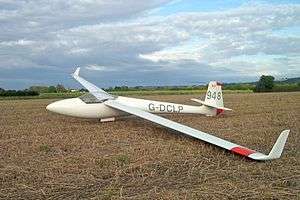Glasflügel H-201
| H-201 Libelle | |
|---|---|
 | |
| Glasflügel H-201 Standard Libelle | |
| Role | Standard-class sailplane |
| National origin | Germany |
| Manufacturer | Glasflügel |
| First flight | October 1967 |
| Number built | 601 |
|
| |
The Glasflügel H-201 Standard Libelle (German: "Dragonfly") is an early composite Standard Class single-seat sailplane produced by Glasflügel from 1967.
Development
The H-201 Standard Libelle was a follow-on Standard Class sailplane to the successful H-301 Libelle Open Class glider. It was similar to the H-301, with modifications to meet the Standard Class requirements. The prototype made its first flight in October 1967, with a total of 601 being built. The type soon made its mark in contest flying; one flown by Per-Axel Persson of Sweden, winner of the 1948 World Championships, came second in the Standard Class at the 1968 World Championships at Leszno in Poland.
The Libelle and Standard Libelle were very popular and influential designs. Their very light wings and extremely easy rigging set a new benchmark. Their handling is generally easy except that they are quite sensitive to sideslipping and have relatively ineffective air brakes that make short landings tricky for inexperienced pilots.
The Standard Libelle was superseded by the Hornet.
Design
The Standard Libelle (H-201) is of similar glassfibre construction to the H-301 Libelle. The changes required consisted of removing the flaps and tail braking parachute, fitting a fixed, instead of retractable, monowheel and raising the height of the canopy. A new Wortmann wing section was featured and terminal velocity dive brakes were fitted.
With a change in the Standard Class rules, the H-201B of 1969 introduced a retractable gear and a water ballast system as an option, with one 25-litre bag per wing located before the spar, with valve and dumping orifice on the fuselage underside. Other improvements in the B variant were larger upper surface dive brakes, a larger stabilizer for better low-speed handling, PVC foam sandwich core for the wing (instead of balsa) to increase durability and profile accuracy, increased gross weight and higher operating speeds.
The canopy is unique in that it has a catch that enables the front to be raised by 25mm (about 1 inch) in flight to provide a blast of ventilating air instead of the more conventional small sliding panel used for this purpose.
The connections for airbrakes and elevator are automatic. The aileron connections are manually connected.
Variants
- Glasflügel 202 (1 built)
- Glasflügel 203 (2 built)
- Glasflügel 204 (1 built)
- Glasflügel 205 Club Libelle with a high-wing, T-tail and fixed undercarriage intended for rental and club use. (171 built)[1][2]
Specifications (H-201B)

General characteristics
- Crew: One pilot
- Capacity: 50 kg (110 lb) water ballast
- Length: 6.19 m (20 ft 4 in)
- Wingspan: 15.00 m (49 ft 3 in)
- Height: 1.25 m (4 ft 1 in)
- Wing area: 9.8 m2 (105 ft2)
- Aspect ratio: 23
- Empty weight: ca. 185 kg (407 lb)
- Gross weight: 350 kg (770 lb)
Performance
- Maximum speed: 250 km/h (160 mph)
- Maximum glide ratio: ca. 38
- Rate of sink: 0.57 m/s (112 ft/min)
See also
- Related lists
References
- ↑ Activate Media (2006). "Club Libelle 205 Glasflugel". Retrieved 10 July 2011.
- ↑ Said, Bob: 1983 Sailplane Directory, Soaring Magazine, page 80, Soaring Society of America November 1983. USPS 499-920
| Wikimedia Commons has media related to H201. |
- Thomas F, Fundamentals of Sailplane Design, College Park Press, 1999
- Simons M, Segelflugzeuge 1965-2000, Eqip, 2004
- Sailplane Directory